

How to Teach Critical Thinking. 6 Apps That Target Higher-Order Thinking Skills. 21st Century Learning 6 Apps That Target Higher-Order Thinking Skills Our expert’s sample activities show how using free tech tools can help students learn to analyze, evaluate and create.
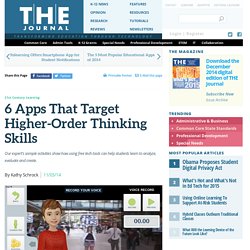
By Kathy Schrock11/03/14 A higher-order thinker is a critical thinker. What are the attributes of a critical thinker? Raises vital questions and problems, formulating them clearly and precisely; gathers and assesses relevant information, using abstract ideas to interpret it effectively; comes to well-reasoned conclusions and solutions, testing them against relevant criteria and standards; thinks open-mindedly within alternative systems of thought, recognizing and assessing their assumptions, implications and practical consequences as need be; and communicates effectively with others in figuring out solutions to complex problems. 7 Actively Engaging Ways of Developing Critical Thinking Skills. We talk to many educators in our travels.

Everywhere we go, we ask what they feel are the most important skills for modern learners. Teachers, school leaders, and educators of all kinds have many shared goals. No matter where they hail from, one of the most common among them is effectively developing critical thinking skills. Thinking critically is the pinnacle of the accumulation of knowledge and experience. How can we start developing our learners’ critical thinking skills rather than teaching to the test? Below is a list of some of the ways we have of developing critical thinking skills the right way for our learners. 1. In short, this means to give to the testers what is theirs but give the freedom to think back to our learners. Essentially, they have carte blanche to work on whatever they wish with whoever they wish. 2. Solving real-world problems gets kids out of the classroom and into the real world. A great place to do this is the Solution Fluency Activity Planner. 10 Ways to Improve Metacognition in Students.
Artful Thinking. Bloom's Taxonomy of Learning Domains: The Cognitive Domain. Bloom's Taxonomy was created in 1956 under the leadership of educational psychologist Dr Benjamin Bloom in order to promote higher forms of thinking in education, such as analyzing and evaluating concepts, processes, procedures, and principles, rather than just remembering facts (rote learning).
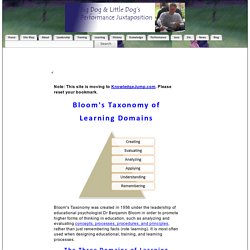
It is most often used when designing educational, training, and learning processes. The Three Domains of Learning The committee identified three domains of educational activities or learning (Bloom, et al. 1956): Cognitive: mental skills (knowledge) Affective: growth in feelings or emotional areas (attitude or self) Psychomotor: manual or physical skills (skills) Since the work was produced by higher education, the words tend to be a little bigger than we normally use. While the committee produced an elaborate compilation for the cognitive and affective domains, they omitted the psychomotor domain. Cognitive Domain Knowledge Comprehension Application Analysis Synthesis Evaluation Next Steps Review. M. Eisenberg - The Big6 Approach to Information & Technology Literacy. Learning that Matters. Critical thinking web. Design Thinking with iPads. Design thinking is a powerful tool to really get your students thinking about and tackling a problem or topic at a much deeper level.
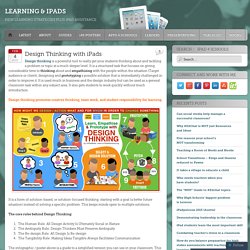
It is a structured task that focuses on giving considerable time to thinking about and empathising with the people within the situation (Target audience or client), designing and prototyping a possible solution that is immediately challenged in order to improve it. It is used much in business and the design industry but can be used as a general classroom task within any subject area. It also gets students to work quickly without much introduction. Design thinking promotes creative thinking, team work, and student responsibility for learning. It is a form of solution-based, or solution-focused thinking; starting with a goal (a better future situation) instead of solving a specific problem. The core rules behind Design Thinking: The infographic / poster above is a guide to a simplified version you can use in your classroom. 1.
“WHAT” = An object – E.g. 2. 3. The Evolution of Trust. HOTandThinkertools - Other HOT Tools. Jing, Free Screenshot and Screencast Software. Learning v2.0 by Mark Treadwell on Prezi. Thinking Routines in the Classroom. Today Karen Voglesang @NBCTchr teaches children to use thinking routines in her classroom.
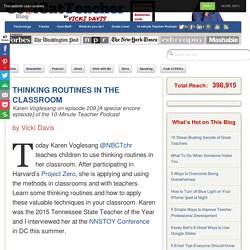
After participating in Harvard’s Project Zero, she is applying and using the methods in classrooms and with teachers. Learn some thinking routines and how to apply these valuable techniques in your classroom. Karen was the 2015 Tennessee State Teacher of the Year and I interviewed her at the NNSTOY Conference in DC this summer. Listen Now. Thinking skills. From Visible Thinking Routines to 5 Modern Learning Routines. I have been a fan of Visible Thinking Routines which were developed by Project Zero from Havard, for a while now.
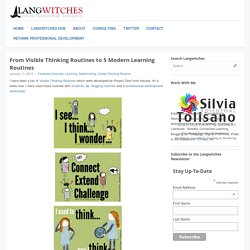
I have used these routines with students, as blogging routines and in professional development workshops. The Visible Thinking Routines website explains that: Routines exist in all classrooms; they are the patterns by which we operate and go about the job of learning and working together in a classroom environment. A routine can be thought of as any procedure, process, or pattern of action that is used repeatedly to manage and facilitate the accomplishment of specific goals or tasks.[…] Classrooms also have routines that structure the way students go about the process of learning As I am trying to make 21st century, modern, contemporary or “now” learning visible, it seemed a natural step to point out “Modern” or “Now” Learning Routines.
Here are my 5 routines that promote modern learning: 1. Read as much as you can on your subject. Comment or annotate on the things you read. 2. WebQuest.